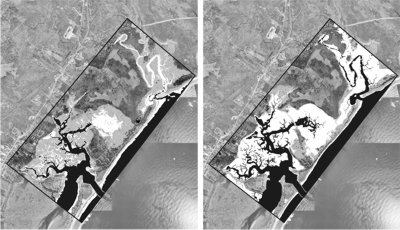
Climate changes everything:
Ecosystem-based management in the sea
By Peter H. Taylor
PERHAPS the biggest buzzwords in coastal and marine management right now are “climate change” and “ecosystem-based management.” Rarely are these interdependent concepts linked the way they should be. A research paper published in March in Science outlines the very real possibility that the sea level could rapidly rise four to six meters (13 to 20 feet) in the next few centuries, far higher than projections often used in management and policy scenarios. The threshold triggering this astounding sea-level rise could be crossed in the coming decades, according to Jonathan Overpeck, a geoscientist at the University of Arizona who co-authored the study. Published in February, another paper titled “The impacts of climate change in coastal marine systems” in Ecology Letters describes a litany of other ways that climate change may shake the foundations of marine ecosystems - from acidification of the ocean to altering routes traveled by young, drifting in-vertebrates and fish. Many people are entirely unaware of these profound shifts identified by Christopher Harley, a zoologist at the University of British Columbia, and his co-authors. The scientific message is that climate change will totally transform marine ecosystems in ways that today's management, conservation and policy paradigms don’t necessarily accommodate, and the biggest changes are yet to come. The core philosophy of ecosystem-based management is to take a broader view of management decisions in order to understand the ecosystem context. If the ecosystem itself will be undergoing massive change, then management decisions must be made in this context, not in the context of today's or tomorrow's conditions. Fundamental ecosystem changes may affect management approaches on seemingly non-climate issues. How fast will the sea rise? The rising sea level usually gets the spotlight when people talk about impacts of climate change on the ocean and coast. Direct human implications of the rising sea level are coastal flooding, accelerated erosion, loss of coastal property and saltwater intrusion into aquifers. Although these threats to human life and property grab headlines, the ecological effects on animals, plants and habitats are no less important. For example, one study estimates that 51 percent of tidal wetlands in Maine will disappear if the sea level rises 20 to 49 centimeters (8 to 19 inches) in the next century; 79 percent will disappear if the sea level rises 86 centimeters (34 inches). Because tidal marshes play a major role in supporting fisheries and marine ecosystems (see Science Insights, Gulf of Maine Times, summer 2005), the loss will be felt far beyond the narrow margin of the coast. In the management and policy realm, the focus is usually on scenarios in which the sea-level rises one to three feet by 2100. Overpeck’s Science paper makes it clear that three feet is by no means the maximum possible increase in sea level. By 2100 the world’s climate may reach temperatures comparable to those of 130,000 to 127,000 years ago, when the sea level was four to six meters (13 to 20 feet) higher than today. Therefore, it’s possible that the sea level will rise faster than one meter, or three feet, per century. Nobody knows precisely how quickly or how high it will rise, but for coastal management and conservation it’s worth looking beyond the standard 100-year scenarios to consider more disastrous and longer-term poss-ibilities. What might happen in the Gulf of Maine, and what are the prudent steps that ought to be taken now? The Ecology Letters paper makes it plain that warmer water will have a range of effects beyond killing species outright or forcing them to shift where they live. Harley and his co-authors provide a comprehensive overview of lesser-known implications of climate change for marine ecosystems. Ultimately, these impacts - altered circulation patterns, elevated carbon dioxide, acidification of seawater and changes in ecosystem functions - could pack more ecologically and economically wallop than the sea-level rise and warmer water. Climate change can magnify other human impacts. The bad news is that climate change cannot be stopped. The good news is that strategically addressing other human impacts on the ocean and coast may help to mitigate climate change. By reshaping the ocean ecosystem, the changing climate sets the context for management and conservation for centuries. It is the defining issue for all management and conservation initiatives in the Gulf of Maine region - all that seek an ecosystem-based approach. Peter Taylor is a consultant working with the Gulf of Maine Science Translation Project.

Printer Friendly Page
What do these changes mean for ecosystem-based management in the Gulf of Maine?
Warming water
Along with the sea-level rise, warmer water temperature is the best understood effect of climate change on the ocean. Already, for example, scien-tists have documented climate-related geographic shifts in North Sea fishes and kelp, barnacles, zooplankton and fish of the northeast Atlantic.
Other ecosystem changes
Changing Circulation
Carbon Dioxide and Acidification
Ecosystem-Level Effects
Compounding the Problem
Visit www.gulfofmaine.org/science_translation.
© 2006 The Gulf of Maine Times
